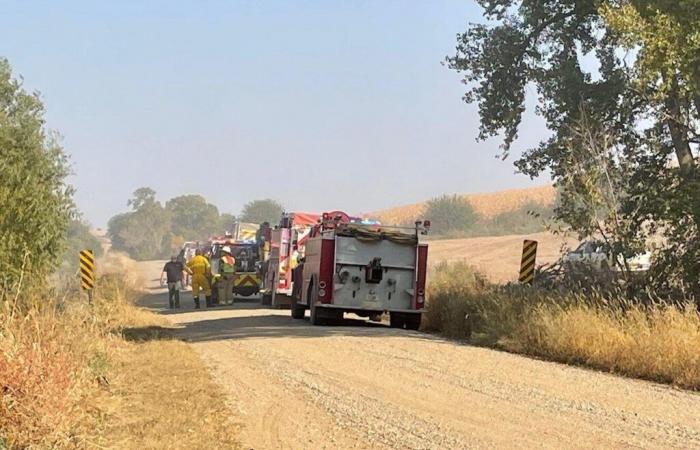SIOUX CITY — Above average temperatures, little to no rainfall and gusty winds are prime conditions to fuel field fires, which have been sparking up across Northwest Iowa as farmers harvest their corn and soybeans.
As Northwest Iowa, Southeast South Dakota and Northeast Nebraska counties are experiencing severe or moderate drought, fire departments in Siouxland are reporting an increase in their call volumes.
Moville Fire Chief Jerry Sailer said responding to field fires “goes in spurts.” He recalled one recent day when the all volunteer fire department was called out to three fires in one day. He said Moville firefighters responded to roughly a dozen such fires in the month of September.
“Because of how dry it is, our call volume is up a lot this year. That’s probably normal for all the departments in the area,” Sailer said. “Almost all of them have been due to harvest. Combines have a lot of moving parts. It’s all mechanical, and things go bad and start the fire. It’s kind of unavoidable, unfortunately. Low humidity, the dryness and the winds make it worse.”
People are also reading…
La Niña, the cool phase of the El Niño-Southern Oscillation (ENSO) cycle, is set to trigger extreme weather events in 2024. Characterized by unusually cold Pacific Ocean temperatures, La Niña strengthens trade winds, pushing warm water westward and upwelling cold water in the east. This climatic shift disrupts weather patterns, leading to wetter conditions in Indonesia, Australia and Malaysia, while intensifying monsoons in India. The US National Oceanic and Atmospheric Administration (NOAA) forecasts a 70% chance of La Niña emerging by October. Historically, La Niña has caused significant flooding in Australia and exacerbated drought conditions in East Africa. In the US, it can fuel a record-breaking Atlantic hurricane season, as seen with Hurricane Beryl, the earliest category five hurricane on record. This phenomenon also has benefits, such as boosting the fishing industry in western South America by promoting nutrient-rich upwelling.
The state is experiencing its second driest October in 152 years of records, Justin Glisan, a state climatologist with the Iowa Department of Agriculture and land Stewardship, noted in the most recently released Iowa Crop Progress and Condition Report.
“Heading into the last stretch of October, temperatures are expected to remain warmer than average with more chances of precipitation, which could slow or temporarily pause harvest in areas,” Iowa Secretary of Agriculture Mike Naig said in the report. “With drought conditions continuing to spread, we would welcome a shot of rain to reduce fire risks, get cover crops established and begin to replenish our soils, streams and pastures.”
Just 0.22 inches of rain fell in the Sioux City area the whole month of September and just a trace had been recorded so far in October, as of Friday afternoon. The monthly average for rainfall for the Sioux City area during September is 2.91 inches and 2.34 inches during October, according to data from the National Weather Service’s website.
Sioux Center recorded more rain in September (0.75 inches) than Sioux City, but the Northwest Iowa city’s total rainfall for the month was still well below the average of 3.23 inches.
Sioux Center Fire Chief Dave Van Holland said firefighters have responded to two fires that were sparked by people throwing cigarettes out of their vehicles.
“That has to do with the dryness, but it also has to do with people being careless,” he said. “With the conditions that they are and as dry as it is, it’s easy to start a fire.”
Van Holland said strong winds have been a big challenge when battling field fires. He said it takes “a lot more of an effort” to extinguish a field fire on a windy day. He said members of the public can help firefighters out by properly disposing of smoking materials and farmers by having a disc in the field when they are working. A disc is a farm implement that, when hooked up to a tractor, can stir up the soil and contain fires.
“Farmers with discs are so much help. It’s like two or three firetrucks being in the field. Those discs are our friends,” he said. “When they see a lot of smoke a mile or two away, they come running. We had a fire last week, and we had 13 discs in the field and 10 more on the way.”
Like Van Holland, Sailer said Moville firefighters seem to respond annually to fires that start in roadside ditches and spread to fields.
“Normally, our presumption is that they started with a discarded cigarette. That’s one thing that the public can certainly help with — not throwing those out your car window,” he said.
Sailer also urged those who live on an acreage to keep their property “tidy” in case a fire would spread from a field to their yard.
“It’s going to go toward their house,” he said. “They can take precautions on that just by keeping the place picked up.”
The Journal’s Jared McNett shows how to download and browse the Sioux City Journal’s app.
Jesse Brothers
Get local news delivered to your inbox!
Subscribe to our Daily Headlines newsletter.







